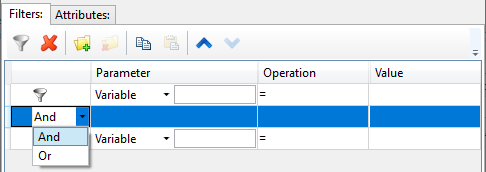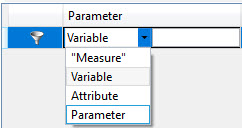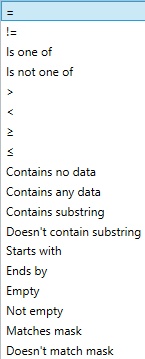Filtering Data Sources of Product Composition |
  
|
The Filters tab of data source properties window contains list of source filtering conditions. Rows of the list represent either a particular condition, or a logical operator defining relations between conditions. Any number of conditions united by And or Or operators can be applied to a data source. The And operator is used by default, when adding multiple conditions. Operator can be changed via the drop-down menu:

Rows of the list can be selected using ![]() . Selected rows are highlighted. In order to select multiple conditions, use <Shift>+
. Selected rows are highlighted. In order to select multiple conditions, use <Shift>+![]() (selects all rows between the currently selected one and the one under the cursor, inclusive) or <Ctrl>+
(selects all rows between the currently selected one and the one under the cursor, inclusive) or <Ctrl>+![]() (adds a row under the cursor to the selection).
(adds a row under the cursor to the selection).
Buttons of following commands are available at the top of the tab:
|
Add condition |
Creates a new condition in the list.
|
Delete condition |
Deletes selected conditions from the list.
|
Group conditions |
Unites selected conditions into a group. Grouped conditions will be considered as a single operand in the list. A group is indicated in the list by the folder icon. Press the ![]() /
/ ![]() button located near the icon in order to unfold/fold the group.
button located near the icon in order to unfold/fold the group.
|
Ungroup conditions |
Breaks selected group.
|
Copy |
Copies selected conditions to the clipboard.
|
Paste |
Pastes conditions from the clipboard.
|
Up |
Moves selected conditions up the list.
|
Down |
Moves selected conditions down the list.
Some of the listed commands are also available in the contextual menu of a condition.
Each condition consists of three components:
A particular property of a data source object is assigned as the Parameter component of the condition. Then an Operation is applied to such property. Most operations compare the Parameter with the Value, using various methods of comparison. The Value is arbitrarily typed in by the user. Some operations do not use values.



The Parameter column of the conditions list consists of two parts. Left part contains the drop-down list, where you can select a type of a parameter. Right part contains the input box, where you should input a name of a parameter via keyboard.
Following types of parameters are available:
•"Measure"
The ![]() Measure command will be applied to the data source object. Then a measurement result, whose name is specified in the adjacent input box, will be used as the condition's parameter. A name of a measurement result should be the same as the one displayed in the Property column of measurement results list.
Measure command will be applied to the data source object. Then a measurement result, whose name is specified in the adjacent input box, will be used as the condition's parameter. A name of a measurement result should be the same as the one displayed in the Property column of measurement results list.
•Variable
This option can be applied only, when assembly fragments are used as data sources. A fragment's variable, whose name is specified in the adjacent input box, will be used as the condition's parameter.
•Attribute
An object's attribute, whose name is specified in the adjacent input box, will be used as the condition's parameter.
•Parameter
An object's parameter, whose name is specified in the adjacent input box, will be used as the condition's parameter. Only the common properties of objects can be used, i.e. the ones that are displayed in the ![]() parameters window, when multiple objects of the same type are selected.
parameters window, when multiple objects of the same type are selected.

You need to select an operation from the drop-down list. It will be performed for the Parameter and Value. Some notes on them:
•Contains no data, Contains any data are used for numeric parameters.
•Empty, Not empty are used for string parameters.
To set additional conditions for adding objects to the product composition is possible to use the mechanism of Masks. Mask is a specialized pattern that is compared to the string values of parameters. To set a mask it is necessary first to choose Matches mask or Doesn’t match mask operation, and then in the Value input box set the mask itself by inputting a combination of symbols.
The following mask symbols are allowed:
Symbol |
Description |
Example |
% |
Any string with zero or more symbols |
«А%» - returns all values that starts with А |
_(bottom dash)
|
Any single symbol |
«А_» - returns all values that has two symbols length and starts with (А1, А2, Аа and so on) |
[ ] |
Any single symbol within the specified range ([a-f]) or set ([abcdef]) |
«[12][0-9]» - returns all values from 10 to 29 |
[^ ] |
Any single symbol not within the specified range ([a-f]) or set ([abcdef) |
«[^0-9]%» - returns all values that do not start with a number. |
You can manage order of logical operations in filters using brackets.
In this input box, you can enter via the keyboard or paste from the clipboard a value, that will be compared with the selected parameter.